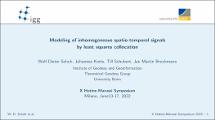Schuh, Wolf-Dieter; Korte, Johannes; Schubert, Till; Brockmann, Jan Martin: Modeling of inhomogeneous spatio-temporal signals by least squares collocation. Bonn: Institute of Geodesy and Geoinformation, Theoretical Geodesy Group, University of Bonn, 2022.
Online-Ausgabe in bonndoc: https://doi.org/10.48565/bonndoc-39
Online-Ausgabe in bonndoc: https://doi.org/10.48565/bonndoc-39
@proceedings{handle:20.500.11811/9917,
doi: https://doi.org/10.48565/bonndoc-39,
author = {{Wolf-Dieter Schuh} and {Johannes Korte} and {Till Schubert} and {Jan Martin Brockmann}},
title = {Modeling of inhomogeneous spatio-temporal signals by least squares collocation},
publisher = {Institute of Geodesy and Geoinformation, Theoretical Geodesy Group, University of Bonn},
year = 2022,
month = jun,
note = {Through inverse modeling and adjustment techniques, the geodesists try to derive mathematical models from their measurements to get a better understanding of various processes in the system Earth. Sophisticated deterministic and stochastic models are developed to achieve the best possible reflection of reality and the remaining uncertainty. While deterministic modeling has been improved by much effort, there are still serious weaknesses in the applied stochastic models and representations. Especially in the collocation approach a remove-restore technique is often used to, on the one hand, guarantee homogeneity and, on the other, get better access to the different frequency contents, which are often hidden in the empirical covariance sequence. The main focus is on the further development of stochastic model representations, which can reflect the full signal content and have the capability to switch from the usual assumption of homogeneous (time-stationary) to inhomogeneous (time-variable) stochastic models. To accomplish this we build up and extent a methodical framework to connect the filter and the covariance approach represented by autoregressive processes (AR) and least squares collocation. The term time-variable is often used differently. Following (Priestley, 1989, Sec. 6.1), time- variable processes can be subdivided into models with a deterministic trend (polynomial or seasonal) and explosive AR processes with roots of the characteristic polynomial outside the unit circle. Here we want to study an other type of non-stationary processes, where the coefficients of an AR-process are variable in time, but does not violate the condition for the roots inside the unit circle. In particular, we examine the time-variable AR-process of first order (AR(1)-process) and put special focus on the inhomogeneity of the first and second central moment, which represents inhomogeneuous covariance relations. We apply these inhomogeneuous covariances to model the temporal component of a spatio-temporal point stack derived from a DInSAR-SBAS analysis of the ERS1 and ERS2 missions. The test region is the Lower-Rhine Embayment in North Rhine-Westphalia, Germany with the still active open-cast mines Garzweiler, Hambach and Inden and the already closed coal mines Sophie-Jacoba in the mining region Erkelenz and Emil Mayrisch in the mining region Aachen. The construction of a time-variable spatio-temporal covariance model allows to use the least squares collocation approach to estimate the vertical movements at any place and at any time and provide a report on the uncertainty of this estimation.},
url = {https://hdl.handle.net/20.500.11811/9917}
}
doi: https://doi.org/10.48565/bonndoc-39,
author = {{Wolf-Dieter Schuh} and {Johannes Korte} and {Till Schubert} and {Jan Martin Brockmann}},
title = {Modeling of inhomogeneous spatio-temporal signals by least squares collocation},
publisher = {Institute of Geodesy and Geoinformation, Theoretical Geodesy Group, University of Bonn},
year = 2022,
month = jun,
note = {Through inverse modeling and adjustment techniques, the geodesists try to derive mathematical models from their measurements to get a better understanding of various processes in the system Earth. Sophisticated deterministic and stochastic models are developed to achieve the best possible reflection of reality and the remaining uncertainty. While deterministic modeling has been improved by much effort, there are still serious weaknesses in the applied stochastic models and representations. Especially in the collocation approach a remove-restore technique is often used to, on the one hand, guarantee homogeneity and, on the other, get better access to the different frequency contents, which are often hidden in the empirical covariance sequence. The main focus is on the further development of stochastic model representations, which can reflect the full signal content and have the capability to switch from the usual assumption of homogeneous (time-stationary) to inhomogeneous (time-variable) stochastic models. To accomplish this we build up and extent a methodical framework to connect the filter and the covariance approach represented by autoregressive processes (AR) and least squares collocation. The term time-variable is often used differently. Following (Priestley, 1989, Sec. 6.1), time- variable processes can be subdivided into models with a deterministic trend (polynomial or seasonal) and explosive AR processes with roots of the characteristic polynomial outside the unit circle. Here we want to study an other type of non-stationary processes, where the coefficients of an AR-process are variable in time, but does not violate the condition for the roots inside the unit circle. In particular, we examine the time-variable AR-process of first order (AR(1)-process) and put special focus on the inhomogeneity of the first and second central moment, which represents inhomogeneuous covariance relations. We apply these inhomogeneuous covariances to model the temporal component of a spatio-temporal point stack derived from a DInSAR-SBAS analysis of the ERS1 and ERS2 missions. The test region is the Lower-Rhine Embayment in North Rhine-Westphalia, Germany with the still active open-cast mines Garzweiler, Hambach and Inden and the already closed coal mines Sophie-Jacoba in the mining region Erkelenz and Emil Mayrisch in the mining region Aachen. The construction of a time-variable spatio-temporal covariance model allows to use the least squares collocation approach to estimate the vertical movements at any place and at any time and provide a report on the uncertainty of this estimation.},
url = {https://hdl.handle.net/20.500.11811/9917}
}






